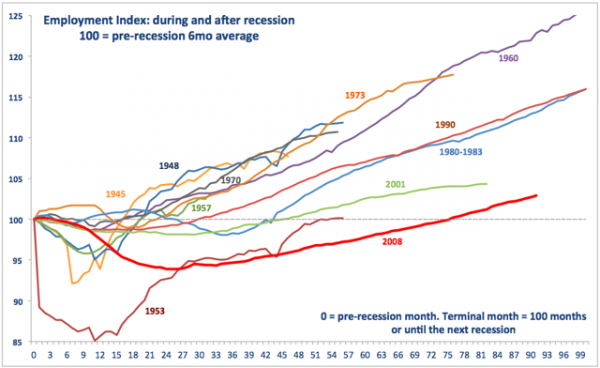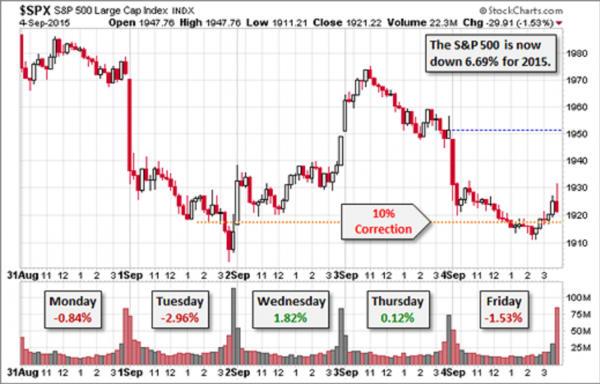Non-Farm Payroll data was a “Ho Hum”. The G20 meeting was almost a non-event. The IMF reiterated the obvious by claiming that the slowdown in China will have global economic impacts, and, in response to these brilliant observations, financial markets have now snapped back into very tight ranging behaviors. The clean up crew is busy picking up the garbage from various market machinations, and stunned pundits are searching for consensus on where markets will head over the next few weeks. In other words, we are right back at Square One, staring at uncertainty on many levels.
September is always the month many of the world’s analysts and investors in general return from vacation, dust off their desks, and review their current outlook for the near-term future. Studies have demonstrated that there is a high probability for a market reversal following long holiday periods, although the change in direction may not happen immediately. Doomsayers have cried “Wolf” for so long a period of time that no one is taking heed of their warnings anymore. Respected market commentators, however, are beginning to show concern and point to compelling charts to support their cases.
September is also the month when we discover if the Fed will blink or follow through on raising its benchmark interest rate by 25 basis points. Recalibration of interest rates, the latest buzzword associated with the process, has been a long time coming. The drivers, according to countless pronouncements by the Fed, have been the employment picture in the U.S. market and the overall health and resilience of the global economy.
Where are we on the U.S. employment front?

Many analysts have described this chart as “scary”, and, as such, it has earned our coveted “Chart of the Week” award. Although a bit complex, it illustrates that our current jobs recovery after a recession has been the longest in duration and shallowest in depth when compared to previous recoveries after World War II. Previous bounce backs have been much quicker and stronger, leading one to conclude that the effects of the Great Recession have been much more devastating than many surmised.
In our economy, jobs growth, along with associated wage increases, provides the disposable income that drives consumer spending on products and services. The real estate market depends on wage growth and has suffered the most over the past seven years. Although the housing market continually shows signs of life in a selection of metropolitan areas, mortgage originations remain tepid, together with lack luster appreciation in home values. The housing bubble that began to form well before 2008 has not been fully re-absorbed.
The good news, however, is that consumers have been buying cars, the second largest item on the household buying list. Figures for auto sales came in last week at a seasonally adjusted 17.7 million annual rate, the best rate in the past ten years and a strong indication of positive consumer sentiment. Non-Farm Payroll data reflected a net increase in 173,000 jobs, when 200,000 was expected, but prior months were adjusted upward, and, historically, August job figures are almost always ratcheted up at a later date. Wage growth also was adjusted to an annual rate of 2.2%, another positive.
The concern, and rightly so, is that the jobs being added are at the low end of the pay scale. Decades of outsourcing and off-shoring of jobs has decimated the middle class, but recent studies have revealed a grimmer insight. Technology has always been our savior, creating new job categories and opportunities for an ever-growing workforce. But technology is a two-edged sword. It destroys jobs before it creates an avalanche of new ones. The issue is that the Internet and the computer age have been destroying jobs more quickly than they have created new ones. As with housing, there is another “gap” that must be worked out of the system before sustainability is alive and well.
Where are we on the global economic front?
The G20 meeting took place over the weekend in Turkey, ostensibly to “halt the recessionary forces overtaking the world economy.” Critics claimed the scene was more about public relations masking the participants’ inability to act on anything. Their communiqué, the third this year, was almost laughable, “Most things are just too low. Growth is too low, productivity is too low, trade numbers are too low, investment is too low, infrastructure projects are too few and the only thing that is too high is unemployment.” Wow! Tell us something we don’t already know!
Was there a sense of urgency to act on the part of these “anointed on high” ministers? Don’t get your hopes up for any decisive policy actions from this crew. Like most government officials the world over, these central bankers just kicked the can down the road until the next meeting in Lima, Peru in October. China was lightly slapped upon the wrist for its surprise devaluation of the Yuan, but, by committing never to devalue again in an attempt to start a currency war, they appeased the attending throngs, except for the Japanese. It seems the weaker Yuan adversely impacted Japan, and their minister was objecting vehemently. Funny how quickly this same minister forgot that his wrist had previously been slapped for the very same reason. Karma – you get what you give.
But the global economy is slowing. The IMF intimated that it would be revising downward its estimates for future global GDP growth. IMF Chief Christine Lagarde did not mince words when she said, “Downside risks to the outlook have increased, particularly for emerging market economies. Against this backdrop, policy priorities have taken on even more urgency since we last met in April. A concerted policy effort is needed to address these challenges, including continued accommodative monetary policy in advanced economies; growth-friendly fiscal policies; and structural reforms to boost potential output and productivity.”
Her call for urgency may save face with the attending press, but none of the finance ministers attending the meeting was suddenly chomping at the bit to change anything. The global economy remains in free fall, while China and its emerging brethren, together with Europe, are hobbling along in low gear. Cheaper commodities have not fueled a major recovery in productive output, as expected. Oil prices fell precipitously again this past month in response to the goings on in China, but the actual truth is that China continues to import seven million barrels a day. Analysts see $60 Dollar oil by January.
Most analysts, however, have generally accepted the S&P 500 Index as being the best gauge of the global economy. On average, nearly 50% of the revenues of the index’s participants are derived from overseas sales or foreign operations. Financial markets, including the forex market, are heavily correlated to what happens here. Last week was a rollercoaster, retesting the lower regions set in August, but the market recovered and rebounded above the so-called “10% Correction” level, as depicted below:

Today, the index is approaching 1980, range bound, it seems, but still probing previous resistance boundaries. There is not much in the way of economic data in the near-term that could excite this market, because all eyes are focused on September 17th, the day the Fed has to put up or shut up. When markets range, pundits have a field day predicting which direction will eventually prevail. The nature of these articles can be categorized as either optimistic or pessimistic.
One analyst summed it up well when he opined, “The optimists include many of the chief global strategists from major firms, professional economists, and investment managers who take a value perspective. The pessimists include most of the trading community, bond managers, ‘independent’ economic thinkers, and conspiracy buffs.” Take your pick. You have a 50% chance of being correct over the remaining months of 2015.
But China is still an issue, if you accept the IMF’s position. China’s foreign exchange reserves fell nearly $100 billion in August, as it sold Treasuries to bolster the value of the Yuan, the real reason the USD depreciated during the previous turmoil. Many believe the Yuan is still overvalued by 15% or more, leading one to believe that more selling of Treasuries is on the near-term horizon. The Yuan will fall due to mounting internal financial pressure, not for trade reasons, as feared by the G20 finance ministers.
Concluding Remarks
And so, we wait. The Fed has backed themselves into the proverbial corner – either come out fighting with a rate increase, or appear like a clown and lackey of the IMF that advised that 2015 was too soon. The last survey on the issue was weeks ago and now is out of date. 80% of economists expected a small increase, but the futures markets have downgraded that estimate to below 25%. Analysts now believe the Fed will act, but will sugarcoat their 25 basis point hike by agreeing to closely monitor the result and by refusing to consider another hike until 2016. Yellen needs to demonstrate confidence.
And what about the global economy? The level of confidence in Chinese officials to manage effectively their quasi-capitalistic economy is waning. Infrastructure spending decisions have been top-down with a “Field of Dreams” belief that if they build it, people will come. They have not. David Stockman, the former Director of the Office of Management and Budget under President Ronald Reagan, was much harsher in his criticism:
“The world is heading into an unprecedented monetary deflation--with output and trade falling nearly everywhere. That implosion is already rumbling through Canada, Mexico, Brazil, Australia, South Korea, Malaysia, Indonesia, Russia, Japan, the Persian Gulf oil states, and countless lesser economies in between. And at the center, of course, is the unraveling of the Great Red Ponzi of China.”
Stockman clearly falls within the parameters of the pessimistic crowd. He has been an incessant critic of central bankers and their near-zero interest rate policies. He, too, is expecting chaos when pent up market forces are finally unleased on Judgment Day. With nearly $11 trillion in carry-trade positions, predominantly in Asia, it does not take a rocket scientist to see the storm clouds forming. Emerging markets have already seen foreign investment capital fleeing across their borders for months.
In the meantime, analysts are revising their yearend predictions in the hopes that chaos is not on our doorsteps. When it comes, it will be a rocky ride! Stay tuned!
Risk Statement: Trading Foreign Exchange on margin carries a high level of risk and may not be suitable for all investors. The possibility exists that you could lose more than your initial deposit. The high degree of leverage can work against you as well as for you.